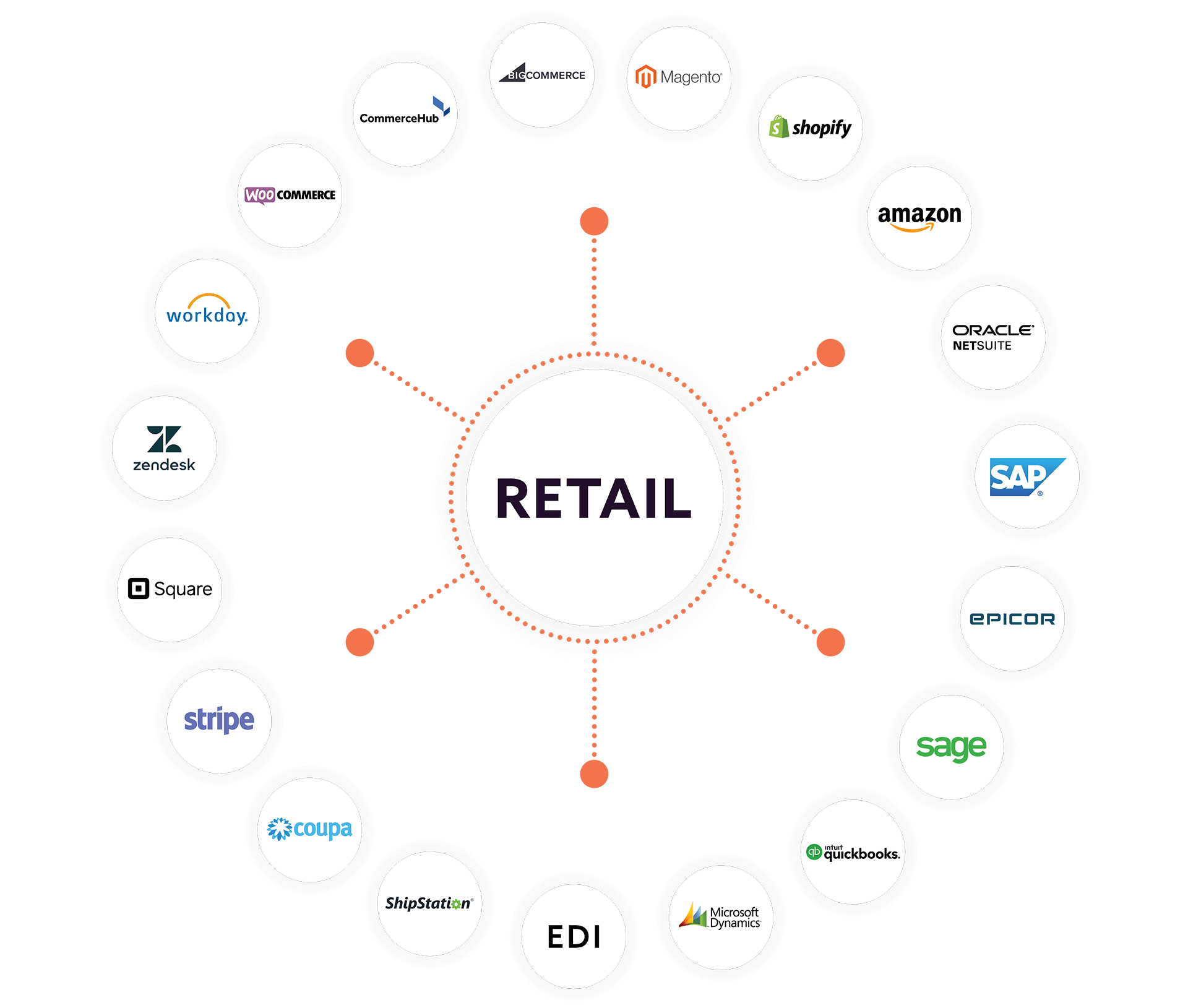Electronic Data Interchange for Retailers and Distributors
Automate your document exchange to save time and money while improving your order fulfillment, supply chain and the customer experience.

For trade to go smoothly, you need smooth operations. Using Electronic Data Interchange (EDI) is a critical component of that. Electronic data interchange (EDI) is a common protocol for information sharing between a supplier and a retailer selling that supplier’s products. When the two parties exchange documents, EDI automates the translation of the data into a standardized format. EDI solutions like ours integrate with your ERP and back-end systems to automatically access and use certain information, or to populate your system with key information that is vital to your business.
Why Retailers and Distributors Need EDI Integration
Many leading retailers require their trading partners to use EDI to ensure optimal order, shipping, payment, inventory processes, and adherence to compliance. Big-box retailers that require EDI include Home Depot, Costco, Amazon, Bed Bath and Beyond, Lowe’s, Bass Pro Shops, Dick’s Sporting Goods, and more.
Without an EDI solution, missteps are likely to happen such as an inaccurate inventory count or lack of adherence to retailer guidelines causing customer attrition, retailer penalties, or loss of business with key stakeholders. Additionally, businesses still rely heavily on manual processes to keep up with orders, so they try to scale by hiring new people only to find this model increases costs and the margin of error. An EDI solution streamlines communications with trading partners and automates processes to reduce costs, eliminate bottlenecks, increase efficiency, and provides real-time visibility into supply chain data.
How EDI Powers Commerce
EDI provides retailers and distributors with a standardized and secure way to communicate with each other–whether it be payment confirmations, shipment instructions, acknowledgments of receipt, and more through the secure transfer of multiple document types. With an EDI solution, these processes are automated, so payments are made faster, error prone processes are eliminated, stock outs are reduced, and processes are optimized so the right goods are delivered to the right place at the right time.
A closer look at how EDI automates processes:
First, the retailer sends an EDI purchase order to the supplier or merchant.
The supplier/merchant sends an EDI acknowledgement back to the retailer, telling the buyer what order(s) can be fulfilled.
The supplier/merchant sends an EDI advance shipping notice to the retailer, which contains information about what’s being sent, when, by whom and more.
Lastly, the supplier sends an EDI invoice to the retailer. The retailer’s accounting team can generate an EDI remittance advice and send it to the supplier to confirm payment.
Why Jitterbit EDI Integration
Experts in Retail
We offer nearly two decades of retail experience and work with merchants of all types, ranging from businesses like Matouk, Idea Village, Topcon, Rubrik, Gourmet Settings, and more.
A Robust Value-Added Network
Our Value-Added Network (VAN) includes thousands of trading partners, including the world’s biggest retailers and wholesalers, such as Amazon, Bed Bath & Beyond, Bass Pro Shops, Lowes, Home Depot, Walmart, Target, and more.
Integration with Any Business System and Any Workflow
Unlike other EDI providers that simply dump transactions into a single system, Jitterbit seamlessly integrates your EDI data into even the most complicated workflows. Data can be instantly managed and synchronized with multiple business applications throughout your enterprise. Our solution does this by integrating with any system, inducing top accounting and ERP systems, such as:
Flexible Delivery: Cloud-based or On-Premise
With our cloud-based solution, your EDI transactions are sent directly via our network. We also offer an on-premise solution, giving you the ability to send your transactions over your servers.
Web-based Dashboard
Our modern, web-based dashboard lets you complete EDI transactions without the need for any custom coding or complex setup. It also provides a centralized view of EDI documents and transactions.
Intuitive, Out-of-the-Box EDI Tools
Streamline the flow of your EDI documents with features such as EDI mapping and management, EDI Dashboard, EDI Acknowledgement, EDI Splitter, and EDI Validator.
Advanced EDI Capabilities
Our cloud-based, software-as-a-service (SaaS) solution eliminates the need to manage and maintain the software required for EDI. Plus, connect with any trading partner, 3PL, or vendor using their preferred communication including AS2, FTP, VAN, X12, EDI, EDIFACT, HL7, and more.
Reliability and Performance
Jitterbit maintains the highest level of performance and reliability and handles production environments that process over 120 million records per day without performance related issues.
Customer Support You Can Depend On
Backed by seasoned EDI professionals with decades of experience, Jitterbit provides unparalleled support with guaranteed rapid response times.




"This [Jitterbit integration] enables all departments to react to the data immediately, driving efficiencies in all corners of the business. What used to be a four-week cycle time to create a custom product was shrunk to two weeks—after just five months.”
EDI Integration FAQs
What is EDI integration and How Does EDI Integration Work?
EDI stands for Electronic Data Interchange and is the exchange and processing of documents electronically, utilizing a standard format. It allows for accurate and reliable transmission of data between your systems and those of your trading partners. EDI integration means the transfer, mapping, and translation of EDI data to and from business applications, and is an important piece of how businesses create efficiencies.
EDI is a critical piece in driving the supply chain across a multitude of verticals including, but not limited to retail, manufacturing, healthcare, insurance, logistics, distribution, automotive, financial services, and government. There are a number of EDI standards & protocols supported to help you with your EDI integration and we continue to add more. We currently maintain a library of over 5,000 standards versions and over 25,000 transaction sets, which are implementations of individual EDI file types.
- Data Formats: All EDI (X12, EDIFACT, TRADACOMS, XML, CICA, HL7, etc.), XML – (WSDL, XSD), cXML, Flat Text Structures, Hierarchical Text Structures, and more…
- Transport Protocols: AS2, FTP/SFTP/FTPS, HTTP/S, Web Services (SOAP, REST), ODBC, JDBC, File Shares, LDAP, SMTP / POP3, and more…
- Platforms: Cloud, Windows, Linux, Solaris
- Enterprise Applications: SAP, Microsoft Dynamics (CRM, AX, GP, NAV, SL) PeopleSoft, Oracle, JD Edwards, and more…
- Databases: Oracle, SQL Server, DB2, MySQL, Sybase, Teradata, and more…
Existing SOA Platforms: webMethods, Tibco, IBM WebSphere, BEA WebLogic, and more… - 3rd Party Applications: QAD, Infor, Vertical Response, Interwoven, AMS Advantage, Microsoft Sharepoint, Documentum, Amazon.com, and more…
- SaaS Applications: Salesforce, NetSuite, Workday, RightNow!, Siebel On-Demand, and more…
- Other Systems: Web Services, XML, Flat and Hierarchical Structures, Legacy, Active Directory, LDAP, and more…
What are Some of the Top EDI Use Cases?
EDI stands for Electronic Data Interchange and is the exchange and processing of documents electronically, utilizing a standard
Types of EDI systems vary depending on business function with common functions ranging from purchasing and accounting, to warehousing and logistics. Specific EDI use cases also exist for healthcare, government, real estate, and other vertical markets. Common business functions automated via EDI integration include:
- Sales & Purchasing: Purchase Orders (PO), PO Acknowledgements/Changes/Adjustments, Order Status Reports/Inquiries
- Finance & Accounting: Invoices, Payment Remittance/Advice, Payment, Acceptance/Rejection, Tax Reporting, Credit/Debit Memos
- Logistics: Advance Ship Notices/Status Messages, Freight Details, Bills of Laing, Prepayment Adjustment Advice
- Marketing: Requests for Quote, Sales Catalog/Pricing, Price Authorization, Product Activity, Sales Tracing
- Inventory: Inventory Adjustments, Planning Schedules, Inventory Advice, Product Transfers/Resales
- Manufacturing: Product Specifications, Test Results, Planning Schedules
- Insurance: Claim Submittal, Claims Tracing, Benefits Enrollment, Eligibility Inquiries
What are the Types of EDI?
The ANSI X12 EDI standard supports over three hundred electronic data interchange types for automating specific business transactions. The most used EDI transaction types for EDI integration include:
- Purchase Orders (850): Terms of sale
- Invoices (810): Request of payment with details
- Purchase Order Acknowledgement (855): Confirmation of the purchase order
- Advance Shipment Notices (856): Goods shipped/packed estimated time
- Product Catalog (832): List of product and services
- Remittance Advance (820): Payment has been made
Why Choose EDI for B2B Integration?
EDI is the preferred method of B2B integration for a majority of businesses and adopted by over 80% of large companies. EDI has a decades-long track record of security, reliability, and scalability in high-volume environments. There are several reasons for EDI’s longevity and wide adoption.
Compared to manual transaction processing, EDI software integration has the following advantages:
- EDI is a requirement for doing business with many retailers, wholesalers, and manufacturers
- Manual data entry is slow and error-laden, impeding order fulfillment and other business functions
- EDI integration allows businesses to optimize cash flow, reduce costs, and redirect resources to other business initiatives
- EDI integration accelerates the cash-to-order cycle and increases ROI by automating these common business tasks
- Successful EDI implementation can reduce costs over 90% compared to manually processing business transactions
Compared to other B2B integration methods, EDI has the following advantages:
- EDI is a widely adopted, and a frequently required, method of B2B integration
- EDI eliminates the need to support multiple, disparate B2B systems
- EDI does not require custom coding or API integration for each Trading Partner
- EDI removes the need to expose sensitive application APIs to the Internet for B2B integration
- Trading Partners can be added in a fraction of the time compared to other B2B integration methods
- EDI can handle a far greater volume of transactions than competing B2B integration methods
Why Choose Jitterbit for EDI Integration?
Ready-Built Connectors
As an Integration Platform as a Service (iPaaS) solution, Jitterbit has ready-built connectors for virtually all major business software packages. Jitterbit’s robust API support allows for the rapid integration of new applications or custom enterprise systems.
Integrate Any Workflow
Unlike other EDI processors that simply dump transactions into a single system, Jitterbit can seamlessly integrate EDI data into even the most complicated business workflow. Data can be instantly managed and synchronized with multiple business applications throughout your enterprise.
Intuitive EDI Tools
Utilize out-of-the-box tools to build out your EDI integration. Easily create and manage your trading partners. Quickly streamline the flow of your EDI documents with features such as EDI mapping and management, EDI Dashboard, EDI Acknowledgement, EDI Splitter, and EDI Validator.
Future-Proof Solution
By eliminating the requirement for custom coding, Jitterbit’s direct EDI integration maintains an unprecedented level of forward compatibility. The impact of future systems upgrades and software migrations is minimized, allowing for near-zero downtime during changes to your IT infrastructure.
Reliability and Performance
Jitterbit maintains the highest level of performance and reliability. Jitterbit is easily able to handle production environments that process over 120 million records per day without performance related issues. Jitterbit can split, manage, and process EDI files containing thousands of individual transactions without error.
Legendary Support
Jitterbit’s direct EDI integration is backed by the highest level of support found anywhere in the B2B industry. Backed by seasoned EDI professionals with decades of experience, Jitterbit provides unparalleled support with guaranteed rapid response times. This level of support, coupled with Jitterbit’s commitment to quality, brings proven performance and peace of mind to B2B integration.


